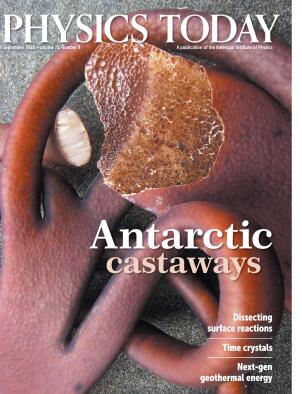Aragonite crystals grow in tight spaces
DOI: 10.1063/PT.3.4016
Calcium carbonate’s two common forms, calcite and aragonite, are widely found in nature—most notably, in the shells of mollusks and sea snails. Aragonite’s abundance is puzzling, though. Despite being only slightly less stable than calcite, aragonite almost never crystallizes from solution in ambient conditions. Researchers seeking the secret to aragonite biomineralization have examined several possibilities—the presence of proteins, scaffold molecules, and organic additives, for instance—all of which can influence nucleation processes. Fiona Meldrum and her colleagues at the University of Leeds in the UK have now shown that the secret may be much simpler: confinement. They found that aragonite crystallizes inside submicron-diameter pores of arbitrary depth without any special additives and in amounts that depend only on the diameter of the pore.

The finding emerged from dozens of experiments using pores created by accelerating heavy ions and shooting them through polycarbonate films. In different-sized pores the researchers precipitated calcium carbonate by mixing two aqueous solutions—one made of calcium chloride and magnesium chloride, the other made of sodium carbonate and sodium sulfate. Analyzing the precipitates with x-ray diffraction and Raman spectroscopy revealed a trend with pore size: As the diameter was reduced from 1200 nm to 25 nm, the percentage of aragonite increased while that of calcite decreased. Whereas the largest pores contained almost entirely calcite, reactions in the smallest ones produced nothing but aragonite rods, as pictured here, even in the absence of magnesium or sulfate ions. The researchers speculate that the effect is attributable to the local ionic environment of the confining, curved surface. A slightly negative charge at the pore membrane produces an inhomogeneous ion distribution near the pore’s center, which is thought to promote the nucleation of aragonite. The effect may also be tunable. A linear relationship exists between the weight percentage of aragonite and the inverse of the pore diameter. (M. Zeng et al., Proc. Natl. Acad. Sci. USA 115, 7670, 2018, doi:10.1073/pnas.1718926115
